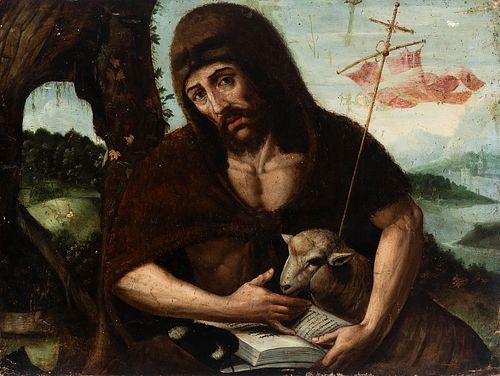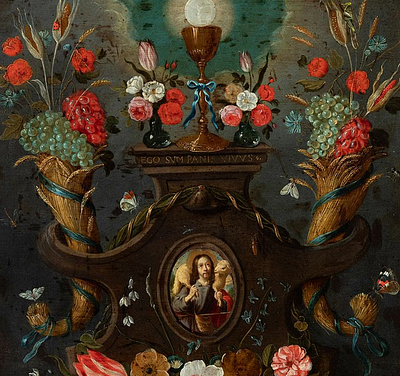Spanish school; late 16th century. "San Juan Bautista" Oil on panel. Crimped. It presents faults, repainting and xylophagous remains.
Lot 2
About Seller
Setdart Auction House
Carrer Aragó 346
Barcelona
Spain
Setdart Subastas was born in 2004 and is currently the first online art auction in Spain with solidity, prestige and reliability guaranteed by our more than 60,000 users. Setdart has a young, dynamic and enterprising team ready to successfully manage the purchase and sale of art works through custom...Read more
Estimate:
EUR€3,500 - EUR€4,000
$3,684.21 - $4,210.53
Absentee vs Live bid
Two ways to bid:
- Leave a max absentee bid and the platform will bid on your behalf up to your maximum bid during the live auction.
- Bid live during the auction and your bids will be submitted real-time to the auctioneer.
Bid Increments
| Price | Bid Increment |
|---|---|
| EUR€0 | EUR€10 |
| EUR€200 | EUR€25 |
| EUR€500 | EUR€50 |
| EUR€1,000 | EUR€100 |
| EUR€3,000 | EUR€200 |
| EUR€5,000 | EUR€500 |
| EUR€10,000 | EUR€1,000 |
| EUR€20,000 | EUR€2,000 |
| EUR€50,000 | EUR€5,000 |
About Auction
By Setdart Auction House
Sep 21, 2021
Set Reminder
2021-09-21 10:00:00
2021-09-21 10:00:00
America/New_York
Bidsquare
Bidsquare : 21st September - ARAS JÁUREGUI Private Collection - Old Masters, 19th & 20th Century
https://www.bidsquare.com/auctions/setdart-auction-house/21st-september---aras-j-uregui-private-collection---old-masters-19th-20th-century-7429
Setdart Auction House sofia@setdart.com
Setdart Auction House sofia@setdart.com
- Lot Description
Spanish school; late 16th century. "San Juan Bautista" Oil on panel. Crimped. It presents faults, repainting and xylophagous remains. Measurements: 49,5 x 66,5 cm. Immersed in a landscape, with a clear sky, the religious figure of San Juan Bautista is presented to us. This can be guessed from the iconographic attributes that accompany the main character, such as the cross of reeds or the lamb. The main figure is presented to the viewer bust-length, which helps to focus attention on his face. The rounded, volumetric forms of the face, characteristic of the period, add intensity and drama to the image of Saint John. The saint, who stands in the centre of the composition, looks at the viewer with a dejected expression, as if he were already aware of his destiny. Although this is not very common, a book can be seen in his hands, alluding to the Holy Scriptures, which in turn is being observed by the little lamb that the saint cradles in one of his arms. The Gospels say of John the Baptist that he was the son of the priest Zechariah and Elizabeth, cousin of the Virgin Mary. He withdrew at a very young age to the desert of Judea to lead an ascetic life and preach penance, and recognised in Jesus, who was baptised by him, the Messiah foretold by the prophets. A year after Christ's baptism, in the year 29, John was arrested and imprisoned by the tetrarch of Galilee Herod Antipas, whose marriage to Herodias, his niece and sister-in-law, he had dared to censure. Finally, St. John was beheaded, and his head given to Salome as a reward for his beautiful dances. This saint appears in Christian art in two different guises: as a child, a playmate of Jesus, and as an adult, an ascetic preacher. The adult Saint John depicted here is dressed in Eastern art in a camel-skin sackcloth, which in the West was replaced by a sheepskin, leaving his arms, legs and part of his torso bare. The red cloak he wears at times, as well as in the scene of his intercession at the Last Judgement, alludes to his martyrdom. In Byzantine art he is depicted as a large-winged angel, with his severed head on a tray which he holds in his hands. However, his attributes in Western art are very different. The most frequent is a lamb, which alludes to Jesus Christ, and he often carries a cross of reeds with a phylactery with the inscription "Ecce Agnus Dei". Painting reflects perhaps better than other artistic fields this desire to return to the classical Greco-Roman world, which exalts the individuality of man, creating a new style whose vitality goes beyond mere copying. Anatomy, the movement of the figures, compositions with a sense of perspective and balance, the naturalistic play of folds and the classical attitudes of the figures soon came to be valued; but the strong Gothic tradition maintained expressiveness as a vehicle for the profound spiritualist sense that informed Renaissance painting. This strong and healthy tradition favours the continuity of religious painting, which accepts the formal beauty offered by Italian Renaissance art with a sense of balance that avoids its predominance over the immaterial content that animates the forms. In the early years of the century, Italian works arrived in our lands and some of our artists went to Italy, where they learned the new standards at first hand in the most progressive centres of Italian art, whether in Florence or Rome, or even in Naples.
- Shipping Info
-
In-house shipping available. Please inquire at admin@setdart.com.
-
- Buyer's Premium



 EUR
EUR CAD
CAD AUD
AUD GBP
GBP MXN
MXN HKD
HKD CNY
CNY MYR
MYR SEK
SEK SGD
SGD CHF
CHF THB
THB
















